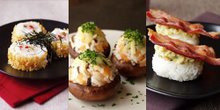
All sushi has a base of specially prepared rice, complemented with other ingredients.
[edit] Sushi rice
Sushi is made with white, short-grained, Japanese rice mixed with a dressing made of rice vinegar, sugar, salt, kombu, and occasionally sake. It is cooled to body temperature before being used. In some fusion cuisine restaurants, short grain brown rice and wild rice are also used.
Sushi rice (sushi-meshi) is prepared with short-grain Japonica rice, which has a consistency that differs from long-grain strains such as Indica. The essential quality is its stickiness. Rice that is too sticky has a mushy texture; if it is not sticky enough, it feels dry. Freshly harvested rice (shinmai) typically has too much water, and requires extra time to drain after washing.
There are regional variations in sushi rice, and of course individual chefs have their individual methods. Most of the variations are in the rice vinegar dressing: the Tokyo version of the dressing commonly uses more salt; in Osaka, the dressing has more sugar.
Sushi rice generally must be used shortly after it is made. The Wiki Cookbook has a simple recipe.
[edit] Nori
The seaweed wrappers used in maki and temaki are called nori. This is an algae traditionally cultivated in the harbors of Japan. Originally, the algae was scraped from dock pilings, rolled out into sheets, and dried in the sun in a process similar to making paper. Nori is toasted before being used in food.
Today, the commercial product is farmed, produced, toasted, packaged, and sold in standard-size sheets, about 18 cm by 21 cm in size. Higher quality nori is thick, smooth, shiny, black, and has no holes.
Nori by itself is edible as a snack. Many children love flavored nori, which is coated with teriyaki sauce. However, those tend to be cheaper, lesser quality nori that is not used for sushi.
[edit] Omelette
Wikibooks
Wikibooks Cookbook has an article on
Inarizushi
When making fukusazushi, a paper-thin omelette may replace a sheet of nori as the wrapping. The omelette is traditionally made in a rectangular omelette pan (makiyakinabe), and used to form the pouch for the rice and fillings.
[edit] Toppings and fillings
Yaki Anago-Ippon-Nigiri (焼きアナゴ一本握り). A roasted and sweet sauced whole conger.
Yaki Anago-Ippon-Nigiri (焼きアナゴ一本握り). A roasted and sweet sauced whole conger.
Main article: List of sushi and sashimi ingredients and styles
* Fish
For culinary, sanitary, and aesthetic reasons, fish eaten raw must be fresher and of higher quality than fish which is cooked.
A professional sushi chef is trained to recognize good fish, which smells clean, has a vivid color, and is free from obvious parasites (many go undetected).
Only ocean fish are used raw in sushi; freshwater fish, which are more likely to harbor parasites, are cooked.
Commonly-used fish are tuna, Japanese amberjack, snapper, conger, mackerel and salmon. The most valued sushi ingredient is toro, the fatty cut of tuna. This comes in varieties ōtoro (often from the bluefin species of tuna) and chutoro, meaning middle toro, implying it is halfway in fattiness between toro and regular red tuna (akami).
* Seafood
Other seafoods are squid, octopus, shrimp, fish roe, sea urchin (uni), and various kinds of shellfish. Oysters, however, are not typically put in sushi because the taste is not thought to go well with the rice. However, some sushi restaurants in New Orleans are known to have Fried Oyster Rolls, and Crawfish rolls.
Ebifurai-Maki(エビフライ巻き). Fried-Shrimp Roll.
Ebifurai-Maki(エビフライ巻き). Fried-Shrimp Roll.
* Vegetables
Pickled daikon radish (takuan) in shinko maki, various pickled vegetables (tsukemono), fermented soybeans (natto) in nattō maki, avocado in California rolls, cucumber in kappa maki, asparagus, yam, tofu, pickled ume (umeboshi), gourd (kampyō), burdock (gobo), and sweet corn mixed with mayonnaise.
* Red meat
Beef, ham, Sausage, and horse meat, often lightly cooked.
Note: It is a common misconception that in Hawaii, fried Spam is a popular local variation of sushi. In reality, Spam musubi differs from sushi in that its rice lacks the vinegar required to classify it as such. Spam musubi is correctly classified as onigiri.
* Other fillings
Eggs (in the form of a slightly sweet, layered omelet called tamagoyaki), raw quail eggs riding as a gunkan-maki topping.
Date-Maki (伊達巻). Futomaki wrapped with sweet-tamagoyaki.
Date-Maki (伊達巻). Futomaki wrapped with sweet-tamagoyaki.
[edit] Condiments
* Shōyu
The common name for soy sauce. In sushi restaurants, may also be referred to as murasaki (lit. "purple").
* Wasabi
A piquant paste made from the grated root of the wasabi plant. Real wasabi (hon-wasabi) is Wasabi japonica. Hon-wasabi has anti-microbial properties and may reduce the risk of food poisoning.[3] The traditional grating tool for wasabi is a sharkskin grater or samegawa oroshi.
An imitation wasabi (seiyo-wasabi), made from horseradish and mustard powder and dyed green, is common. It is found at lower-end kaiten zushi restaurants, in bento box sushi, and at most restaurants outside of Japan, If it is manufactured in Japan, it may be labelled "Japanese Horseradish".[4]
In sushi restaurants, wasabi may be referred to as namida ("tears").
* Gari
Sweet, pickled ginger. Eaten to both cleanse the palette as well as to aid in the digestive process.
* Ocha
In Japan, green tea (ocha) is invariably served together with sushi. Better sushi restaurants often use a distinctive premium tea known as mecha. In sushi vocabulary, green tea is known as agari.
